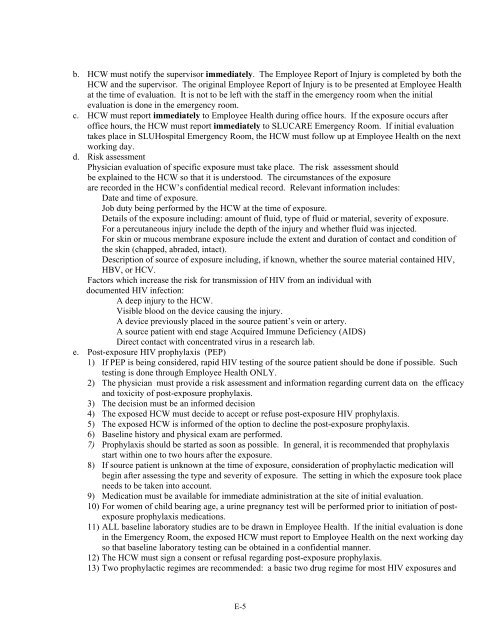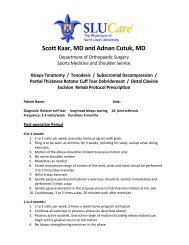Program Manual - Saint Louis University
Program Manual - Saint Louis University
Program Manual - Saint Louis University
Create successful ePaper yourself
Turn your PDF publications into a flip-book with our unique Google optimized e-Paper software.
. HCW must notify the supervisor immediately. The Employee Report of Injury is completed by both the<br />
HCW and the supervisor. The original Employee Report of Injury is to be presented at Employee Health<br />
at the time of evaluation. It is not to be left with the staff in the emergency room when the initial<br />
evaluation is done in the emergency room.<br />
c. HCW must report immediately to Employee Health during office hours. If the exposure occurs after<br />
office hours, the HCW must report immediately to SLUCARE Emergency Room. If initial evaluation<br />
takes place in SLUHospital Emergency Room, the HCW must follow up at Employee Health on the next<br />
working day.<br />
d. Risk assessment<br />
Physician evaluation of specific exposure must take place. The risk assessment should<br />
be explained to the HCW so that it is understood. The circumstances of the exposure<br />
are recorded in the HCW’s confidential medical record. Relevant information includes:<br />
Date and time of exposure.<br />
Job duty being performed by the HCW at the time of exposure.<br />
Details of the exposure including: amount of fluid, type of fluid or material, severity of exposure.<br />
For a percutaneous injury include the depth of the injury and whether fluid was injected.<br />
For skin or mucous membrane exposure include the extent and duration of contact and condition of<br />
the skin (chapped, abraded, intact).<br />
Description of source of exposure including, if known, whether the source material contained HIV,<br />
HBV, or HCV.<br />
Factors which increase the risk for transmission of HIV from an individual with<br />
documented HIV infection:<br />
A deep injury to the HCW.<br />
Visible blood on the device causing the injury.<br />
A device previously placed in the source patient’s vein or artery.<br />
A source patient with end stage Acquired Immune Deficiency (AIDS)<br />
Direct contact with concentrated virus in a research lab.<br />
e. Post-exposure HIV prophylaxis (PEP)<br />
1) If PEP is being considered, rapid HIV testing of the source patient should be done if possible. Such<br />
testing is done through Employee Health ONLY.<br />
2) The physician must provide a risk assessment and information regarding current data on the efficacy<br />
and toxicity of post-exposure prophylaxis.<br />
3) The decision must be an informed decision<br />
4) The exposed HCW must decide to accept or refuse post-exposure HIV prophylaxis.<br />
5) The exposed HCW is informed of the option to decline the post-exposure prophylaxis.<br />
6) Baseline history and physical exam are performed.<br />
7) Prophylaxis should be started as soon as possible. In general, it is recommended that prophylaxis<br />
start within one to two hours after the exposure.<br />
8) If source patient is unknown at the time of exposure, consideration of prophylactic medication will<br />
begin after assessing the type and severity of exposure. The setting in which the exposure took place<br />
needs to be taken into account.<br />
9) Medication must be available for immediate administration at the site of initial evaluation.<br />
10) For women of child bearing age, a urine pregnancy test will be performed prior to initiation of postexposure<br />
prophylaxis medications.<br />
11) ALL baseline laboratory studies are to be drawn in Employee Health. If the initial evaluation is done<br />
in the Emergency Room, the exposed HCW must report to Employee Health on the next working day<br />
so that baseline laboratory testing can be obtained in a confidential manner.<br />
12) The HCW must sign a consent or refusal regarding post-exposure prophylaxis.<br />
13) Two prophylactic regimes are recommended: a basic two drug regime for most HIV exposures and<br />
E-5

















